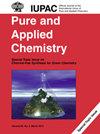Landolphia owariensis 叶甲醇提取物对不同薯蓣品种中分离出的病原真菌的生物学潜力
IF 2
4区 化学
Q3 CHEMISTRY, MULTIDISCIPLINARY
引用次数: 0
摘要
就经济意义而言,薯蓣科(包括著名的薯蓣属)是全球第四大块茎作物。山药是世界各地都有的基本食物,它鼓励并确保了家庭的粮食安全。虽然山药的保存和储藏具有挑战性,但必须制定收获后的变质控制措施。多年来,尼日利亚农民一直使用药草来控制收获后害虫的入侵;然而,这种真菌管理的科学依据尚未得到很好的记录。因此,Landolphia owarensis 叶提取物被用作生物防治手段,并从 Dioscorea cayenensis、Dioscorea alata 和 Discorea rotundata 中分离出真菌。山药块茎样本(包括腐烂的和健康的)都是从市场上购买的,然后带到实验室进行真菌分离和鉴定。采集芋头叶,风干,研磨,在纯甲醇中浸泡 72 小时,用旋转蒸发仪提取和浓缩。采用琼脂-孔扩散法对真菌分离物进行生物防治检测。生物防治结果以平均值 ± SD(标准偏差)表示,同时使用方差分析(Anova)来推断最小显著差异(LSD)。共观察到 605 株真菌分离物,其中卡宴草真菌分离物最多,占 50.58%,阿拉塔草真菌分离物占 24.71%,罗盘草真菌分离物占 24.71%。黑曲霉和烟曲霉在这三个物种中都有发现,而黄曲霉、匍匐根根瘤癣菌、科伦特癣菌属和青霉属在其中任何一个物种中都有发现。L. owarensis 的甲醇叶提取物只对 Colletotrium spp.、A. fumigatus、A. niger 和 A. flavus 具有生物潜力。作为一种生物控制措施,L. owarensis 甲醇叶提取物可抑制收获后真菌对薯蓣物种的入侵,从而解决世界粮食安全问题。本文章由计算机程序翻译,如有差异,请以英文原文为准。
Biological potentials of Landolphia owariensis leaf methanolic extract against pathogenic fungi isolates from different Dioscorea species
Regarding economic significance, the Dioscoreaceae family, which includes the well-known Dioscorea (yam) species, is the fourth most important tuber crop globally. A basic meal found all across the world, yams encourage and ensure the food security of households. Although they are challenging to preserve and store however a post-harvest deterioration control must be developed. Over the years, Nigerian farmers have employed medicinal herbs to manage post-harvest pest invasion; nevertheless, the scientific basis for this fungal management has not yet been well documented. As a result, Landolphia owarensis leaf extract was used as a biological control, and fungi were isolated from Dioscorea cayenensis , Dioscorea alata , and Discorea rotundata . Samples of yam tubers – both rotten and healthy – were procured in the markets and brought to the lab for fungus isolation and identification. Leaves of Landolphia oweriensis were collected, air-dried, milled, and macerated in pure methanol for 72 h, extracted and concentrated with a rotary evaporator. The agar-well diffusion method was used for the biological control assay against the fungal isolates. The biological control results were presented as mean ± SD (standard deviation) while analysis of variance (Anova) was used to deduce least significant difference (LSD). A total number of 605 fungi isolates were observed in which D . cayenensis had the highest, 50.58 %, D. alata and Discorea rotundata 24.71 % respectively. Aspergillus niger and Aspergillus fumigatus were found in the three species while Aspergillus flavus , Rhizopus stolonifer , Collentotricum spp . and Penicillium spp . in either of the species. L. owarensis methanolic leaves extracts possesses biological potentials against Colletotrium spp., A. fumigatus , A. niger and A. flavus only. The problem of postharvest fungal invasion of Dioscorea species can be solved with the inhibition observed with L. owarensis methanolic leaves extracts as a biological control measure thereby sustaining food security in the world.
求助全文
通过发布文献求助,成功后即可免费获取论文全文。
去求助
来源期刊

Pure and Applied Chemistry
化学-化学综合
CiteScore
4.00
自引率
0.00%
发文量
60
审稿时长
3-8 weeks
期刊介绍:
Pure and Applied Chemistry is the official monthly Journal of IUPAC, with responsibility for publishing works arising from those international scientific events and projects that are sponsored and undertaken by the Union. The policy is to publish highly topical and credible works at the forefront of all aspects of pure and applied chemistry, and the attendant goal is to promote widespread acceptance of the Journal as an authoritative and indispensable holding in academic and institutional libraries.
 求助内容:
求助内容: 应助结果提醒方式:
应助结果提醒方式:


